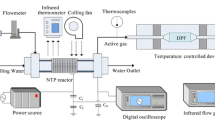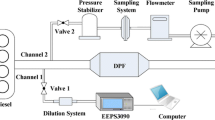Abstract
A non-thermal plasma (NTP) reactor was used to generate ozone for diesel particulate filter (DPF) regeneration. The kinetic mechanism of ozone thermal decomposition reaction is explored, and the effect of temperature on the change of ozone concentration is analyzed. The changes of the internal temperature and the concentration of regeneration products such as CO2 and CO during the regeneration under constant temperature and non-constant temperature conditions are then studied and the influence of different regeneration environments on the regeneration is analyzed in combination with the decomposition law of ozone. In the non-constant temperature condition, DPF surface temperature changes significantly with time. The results show that when using an NTP reactor to generate ozone, the activation energy of the decomposition reaction is 2.80755 × 104 J/mol and the law of thermal decomposition reaction can be described as \(k = 190.76 \times {e^{( - 2.80755 \times {{10}^4}/RT)}}\). During DPF regeneration, the overall regeneration rate and ozone utilization rate in the non-constant temperature environment are higher than in the constant temperature environment and the temperature change (delta-T) peak rises with the increase of PM deposition. The regeneration with NTP under non-constant thermal condition is an effective way to improve the efficiency of DPF regeneration.
Similar content being viewed by others
References
Babaie, M., Davari, P., Talebizadeh, P., Zare, F., Rahimzadeh, H., Ristovski, Z. and Brown, R. (2015). Performance evaluation of non-thermal plasma on particulate matter, ozone and CO2 correlation for diesel exhaust emission reduction. Chemical Engineering J.. 276, 240–248.
Chen, K. S. M. K., Martirosyan, K. S. and Luss, D. (2011). Transient temperature rise during regeneration of diesel particulate filters. Chemical Engineering J., 176, 144–150.
Donaldson, K., Mills, N., MacNee, W., Robinson, S. and Newby, D. (2005). Role of Inflammation in cardiopulmonary health effects of PM. Toxicology and Applied Pharmacology 207, 2, 483–488.
Fowler, D., Flechard, C., Cape, J. N., Storeton-West, R. L. and Coyle, M. (2001). Measurements of ozone deposition to vegetation quantifing the flux, the stomatal and non-stomatal components. Water, Air, and Soil Pollution 130, 1, 63–74.
Gao, J., Ma, C., Xia, F., Xing, S., Sun, L. and Huang, L. (2016). Raman characteristics of PM emitted by a diesel engine equipped with a NTP reactor. Fuel, 185, 289–297.
Ghadikolaei, M. A., Yung, K. F., Cheung, C. S. and Lau, P. C. (2019). Chemical properties and composition of PM emitted from a diesel engine fueled with ternary fuel (diesel-biodiesel-ethanol) in blended and fumigation modes. Fuel, 251, 368–382.
Haralampous, O. and Koltsakis, G. C. (2002). Intra-Layer temperature gradients during regeneration of diesel particulate filters. Chemical Engineering Science 57, 13, 2345–2355.
Harano, A., Murata, K., Takamizawa, K. and Sadakata, M. (1998). Oxidation of carbonaceous particles in silent discharge reactor. J. Chemical Engineering of Japan 31, 5, 700–705.
Hołub, M., Kalisiak, S., Borkowski, T., Myśków, J. and Brandenburg, R. (2010). The influence of direct nonthermal plasma treatment on particulate matter (PM) and NOx in the exhaust of marine diesel engines. Polish J. Environmental Studies 19, 6, 1199–1211.
Hou, X., Ma, Y., Peng, F., Yan, F. and Zhang, X. (2010). Research on temperature characteristics of DPF regeneration technology based on catalytic combustion of fuel injection. Asia-Pacific Power and Energy Engineering Conf., Chengdu, China.
Jodzis, S. and Zięba, M. (2018). Energy efficiency of an ozone generation process in oxygen. Analysis of a pulsed DBD system. Vacuum, 155, 29–37.
Koike, K., Inoue, G., Suzuki, M., Saida, J., and Komatsu, I. (1998). Decomposition characteristics of concentrated ozone. J. Chemical Engineering of Japan 31, 2, 195–200. (not quoted)
Kuwahara, T., Nishii, S., Kuroki, T. and Okubo, M. (2013). Complete regeneration characteristics of diesel particulate filter using ozone injection. Applied Energy, 111, 652–656.
Liang, F., Lu, M., Keener, T. C., Liu, Z. and Khang, S. J. (2005). The organic composition of diesel particulate matter, diesel fuel and engine oil of a non-road diesel generator. J. Environmental Monitoring 7, 10, 983–988.
Ma, C., Gao, J., Zhong, L. and Xing, S. (2016). Experimental investigation of the oxidation behaviour and thermal kinetics of diesel particulate matter with non-thermal plasma. Applied Thermal Engineering 99, 1110–1118.
McEntee, J. C. and Ogneva-Hrmmelberger, Y. (2008). Diesel particulate matter, lung cancer, and asthma incidences along major traffic corridors in MA, USA: A GIS analysis. Health & Place 14, 4, 817–828.
Okubo, M., Arita, N., Kuroki, T. and Yamamoto, T. (2007). Carbon particulate matter incineration in diesel engine emissions using indirect nonthermal plasma processing. Thin Solid Films 515, 9, 4289–4295.
Oskooei, A. B., Koohsorkhi, J. and Mehrpooya, M. (2019). Simulation of plasma-assisted catalytic reduction of NOx, CO, and HC from diesel engines exhaust with COMSOL. Chemical Engineering Science, 197, 135–149. (not quoted)
Pu, X., Cai, Y., Shi, Y., Wang, J., Gu, L., Tian, J. and Cui, Y. (2017). Test on diesel particulate filter regeneration using non-thermal plasma technology aided by exhaust waste heat. Trans. Chinese Society of Agricultural Engineering 33, 14, 70–77.
Shi, Y., Cai, Y., Fan, R., Cui, Y., Chen, Y. and Ji, L. (2019a). Characterization of soot inside a diesel particulate filter during a nonthermal plasma promoted regeneration step. Applied Thermal Engineering, 150, 612–619.
Shi, Y., Cai, Y., Li, X., Ji, L., Chen, Y. and Wang, W. (2019b). Evolution of diesel particulate physicochemical properties using nonthermal plasma. Fuel, 253, 1292–1299.
Talebizadeh, P., Babaie, M., Brown, R., Rahimzadeh, H., Ristovski, Z. and Arai, M. (2014). The role of non-thermal plasma technique in NOx treatment: A review. Renewable and Sustainable Energy Reviews, 40, 886–901.
Tan, P. Q., Hu, Z. Y. and Lou, D. M. (2008). Effects of diesel particulate filter structural parameters on filtration performance of different size particles. Chinese J. Mechanical Engineering 44, 2, 175–181.
Ulrich, M. M., Alink, G. M., Kumarathasan, P., Vincent, R., Boere, A. J. F. and Cassee, F. R. (2002). Health effects and time course of particulate matter on the cardiopulmonary system in rats with lung inflammation. J. Toxicology and Environmental Health, Part A 65, 20, 1571–1595.
Wang, X., Wang, Y., Bai, Y., Wang, P. and Zhao, Y. (2019). An overview of physical and chemical features of diesel exhaust particles. J. Energy Institute 92, 6, 1864–1888.
Yang, J., Stewart, M., Maupin, G., Herling, D. and Zelenyuk, A. (2009). Single wall diesel particulate filter (DPF) filtration efficiency studies using laboratory generated particles. Chemical Engineering Science 64, 8, 1625–1634.
Acknowledgement
This work is currently supported by the National Natural Science Foundation of China (51806085, 51676089), the China Postdoctoral Science Foundation Project (2018M642175), the Double Innovation talents of Jiangsu Province and Jiangsu University Youth Talent Cultivation Program Funded Project, and Postgraduate Research & Practice Innovation Program of Jiangsu Province (KYCX19_1604).
Author information
Authors and Affiliations
Corresponding author
Additional information
Publisher’s Note
Springer Nature remains neutral with regard to jurisdictional claims in published maps and institutional affiliations.
Rights and permissions
About this article
Cite this article
Wang, W., Cai, Y., Shi, Y. et al. Experimental Investigation of Ozone Decomposition in Diesel Particulate Filter Regeneration with Non-Thermal Plasma Technology. Int.J Automot. Technol. 22, 871–881 (2021). https://doi.org/10.1007/s12239-021-0079-2
Received:
Revised:
Accepted:
Published:
Issue Date:
DOI: https://doi.org/10.1007/s12239-021-0079-2




